BTEC Higher National Diploma Food Safety Management Report
VerifiedAdded on 2020/05/08
|19
|4057
|44
Report
AI Summary
This report, submitted by Iyabode Sulemon for the BTEC Higher National Diploma in Hospitality Management (Unit 31), provides a comprehensive overview of food safety management. It delves into key steps in temperature control systems, methods for safe food storage, and the importance of personal hygiene in preventing contamination. The report evaluates cleaning and disinfection processes, discusses problems associated with pest control, and justifies the need for hygienic design in food premises. Furthermore, it emphasizes the importance of training as a quality assurance mechanism, including a food hazard risk assessment and a guide to food safety legislation. The report covers various aspects of food safety in detail, providing insights into best practices for maintaining food safety standards in the hospitality industry. The report is a valuable resource for students studying food safety management and provides a practical approach to handling food safety challenges.
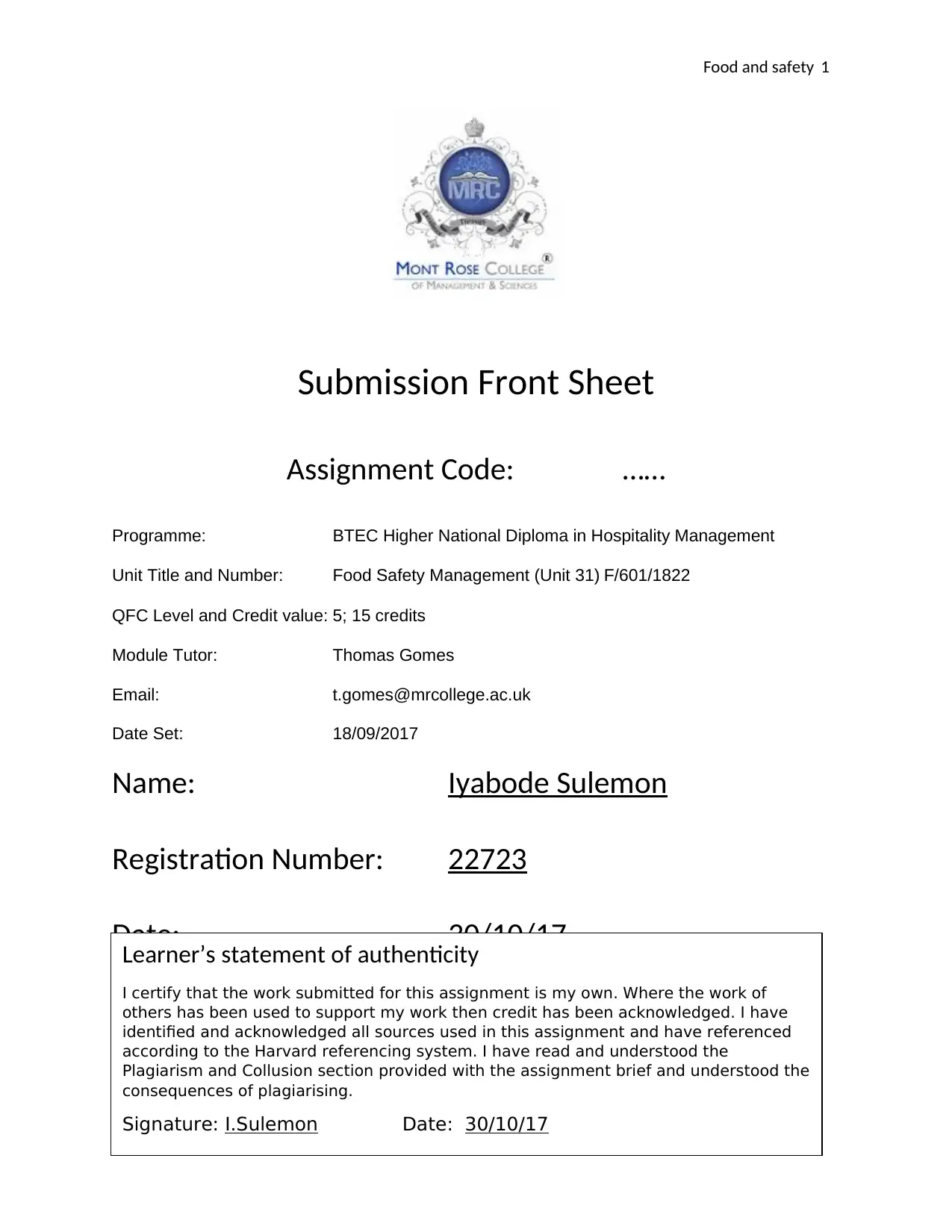
Food and safety 1
Submission Front Sheet
Assignment Code: ……
Programme: BTEC Higher National Diploma in Hospitality Management
Unit Title and Number: Food Safety Management (Unit 31) F/601/1822
QFC Level and Credit value: 5; 15 credits
Module Tutor: Thomas Gomes
Email: t.gomes@mrcollege.ac.uk
Date Set: 18/09/2017
Name: Iyabode Sulemon
Registration Number: 22723
Date: 30/10/17
Learner’s statement of authenticity
I certify that the work submitted for this assignment is my own. Where the work of
others has been used to support my work then credit has been acknowledged. I have
identified and acknowledged all sources used in this assignment and have referenced
according to the Harvard referencing system. I have read and understood the
Plagiarism and Collusion section provided with the assignment brief and understood the
consequences of plagiarising.
Signature: I.Sulemon Date: 30/10/17
Submission Front Sheet
Assignment Code: ……
Programme: BTEC Higher National Diploma in Hospitality Management
Unit Title and Number: Food Safety Management (Unit 31) F/601/1822
QFC Level and Credit value: 5; 15 credits
Module Tutor: Thomas Gomes
Email: t.gomes@mrcollege.ac.uk
Date Set: 18/09/2017
Name: Iyabode Sulemon
Registration Number: 22723
Date: 30/10/17
Learner’s statement of authenticity
I certify that the work submitted for this assignment is my own. Where the work of
others has been used to support my work then credit has been acknowledged. I have
identified and acknowledged all sources used in this assignment and have referenced
according to the Harvard referencing system. I have read and understood the
Plagiarism and Collusion section provided with the assignment brief and understood the
consequences of plagiarising.
Signature: I.Sulemon Date: 30/10/17
Paraphrase This Document
Need a fresh take? Get an instant paraphrase of this document with our AI Paraphraser
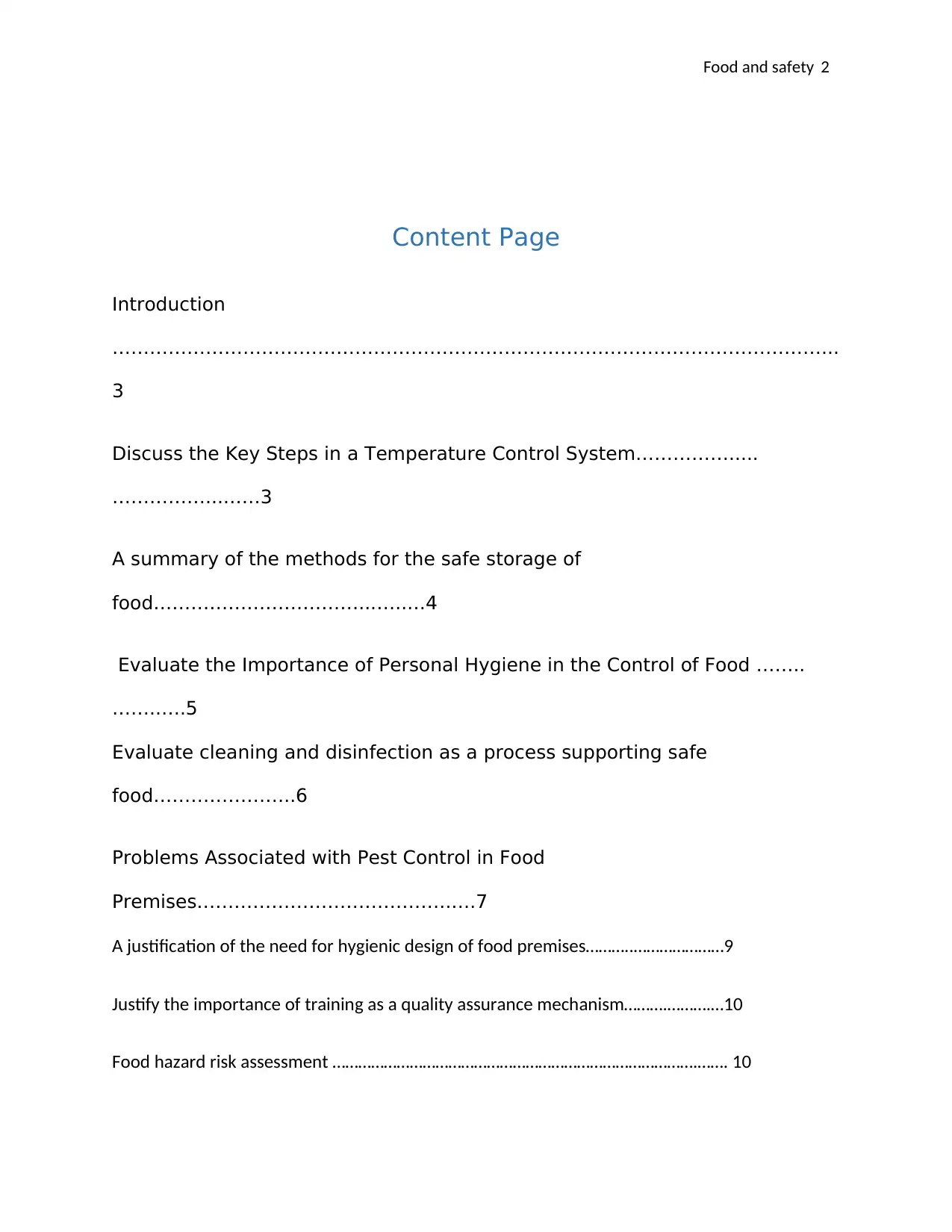
Food and safety 2
Content Page
Introduction
……………………………………………………………………………………………………...
3
Discuss the Key Steps in a Temperature Control System…………….....
……………...……3
A summary of the methods for the safe storage of
food……………………………...…..…4
Evaluate the Importance of Personal Hygiene in the Control of Food ……..
……..….5
Evaluate cleaning and disinfection as a process supporting safe
food…………………..6
Problems Associated with Pest Control in Food
Premises…………………………………..….7
A justification of the need for hygienic design of food premises………..…………………9
Justify the importance of training as a quality assurance mechanism……….……….…10
Food hazard risk assessment ………………………………………………………………………….……. 10
Content Page
Introduction
……………………………………………………………………………………………………...
3
Discuss the Key Steps in a Temperature Control System…………….....
……………...……3
A summary of the methods for the safe storage of
food……………………………...…..…4
Evaluate the Importance of Personal Hygiene in the Control of Food ……..
……..….5
Evaluate cleaning and disinfection as a process supporting safe
food…………………..6
Problems Associated with Pest Control in Food
Premises…………………………………..….7
A justification of the need for hygienic design of food premises………..…………………9
Justify the importance of training as a quality assurance mechanism……….……….…10
Food hazard risk assessment ………………………………………………………………………….……. 10
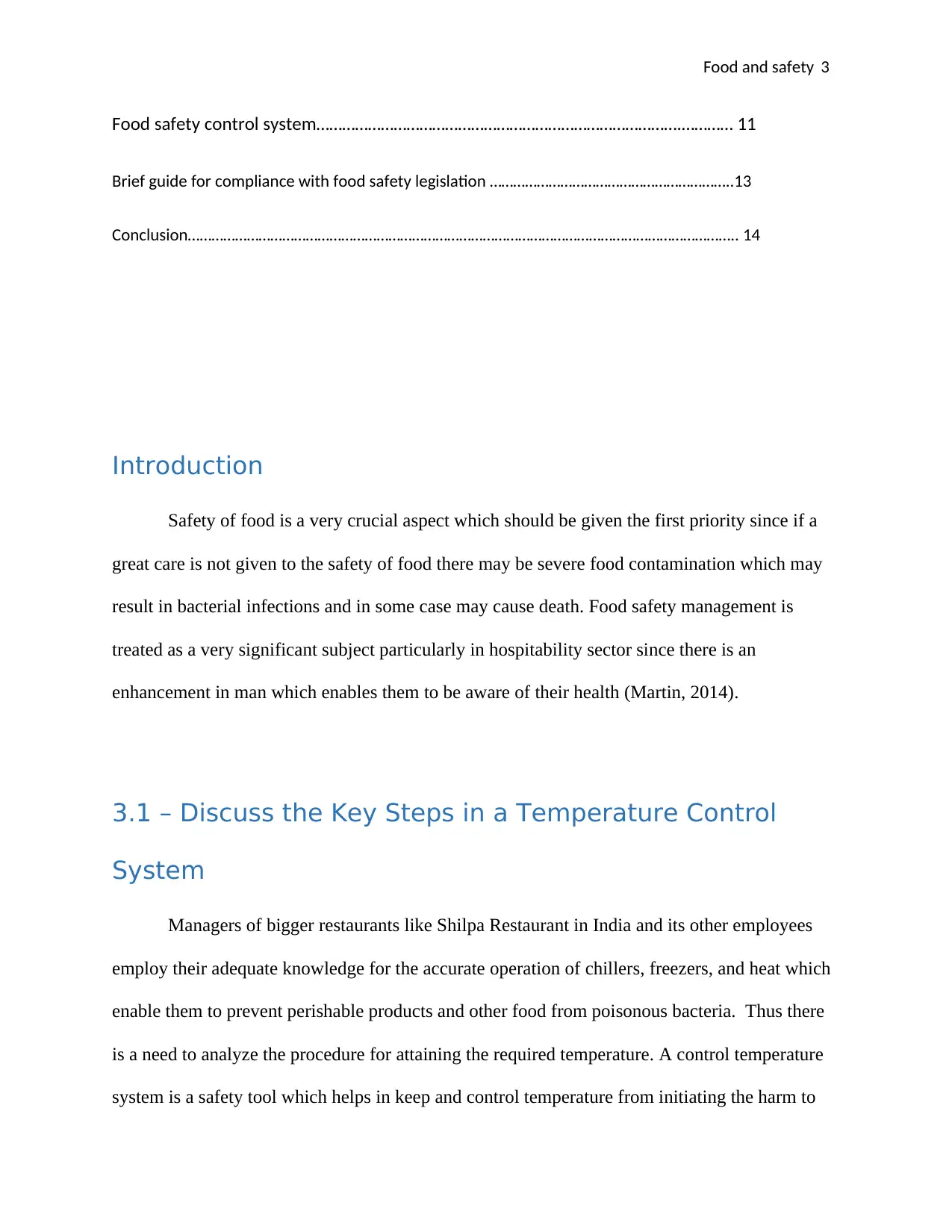
Food and safety 3
Food safety control system………………………………………………………………………….………… 11
Brief guide for compliance with food safety legislation ……………………………………………………..13
Conclusion………………………………………………………………………………………………………………………….. 14
Introduction
Safety of food is a very crucial aspect which should be given the first priority since if a
great care is not given to the safety of food there may be severe food contamination which may
result in bacterial infections and in some case may cause death. Food safety management is
treated as a very significant subject particularly in hospitability sector since there is an
enhancement in man which enables them to be aware of their health (Martin, 2014).
3.1 – Discuss the Key Steps in a Temperature Control
System
Managers of bigger restaurants like Shilpa Restaurant in India and its other employees
employ their adequate knowledge for the accurate operation of chillers, freezers, and heat which
enable them to prevent perishable products and other food from poisonous bacteria. Thus there
is a need to analyze the procedure for attaining the required temperature. A control temperature
system is a safety tool which helps in keep and control temperature from initiating the harm to
Food safety control system………………………………………………………………………….………… 11
Brief guide for compliance with food safety legislation ……………………………………………………..13
Conclusion………………………………………………………………………………………………………………………….. 14
Introduction
Safety of food is a very crucial aspect which should be given the first priority since if a
great care is not given to the safety of food there may be severe food contamination which may
result in bacterial infections and in some case may cause death. Food safety management is
treated as a very significant subject particularly in hospitability sector since there is an
enhancement in man which enables them to be aware of their health (Martin, 2014).
3.1 – Discuss the Key Steps in a Temperature Control
System
Managers of bigger restaurants like Shilpa Restaurant in India and its other employees
employ their adequate knowledge for the accurate operation of chillers, freezers, and heat which
enable them to prevent perishable products and other food from poisonous bacteria. Thus there
is a need to analyze the procedure for attaining the required temperature. A control temperature
system is a safety tool which helps in keep and control temperature from initiating the harm to
⊘ This is a preview!⊘
Do you want full access?
Subscribe today to unlock all pages.

Trusted by 1+ million students worldwide
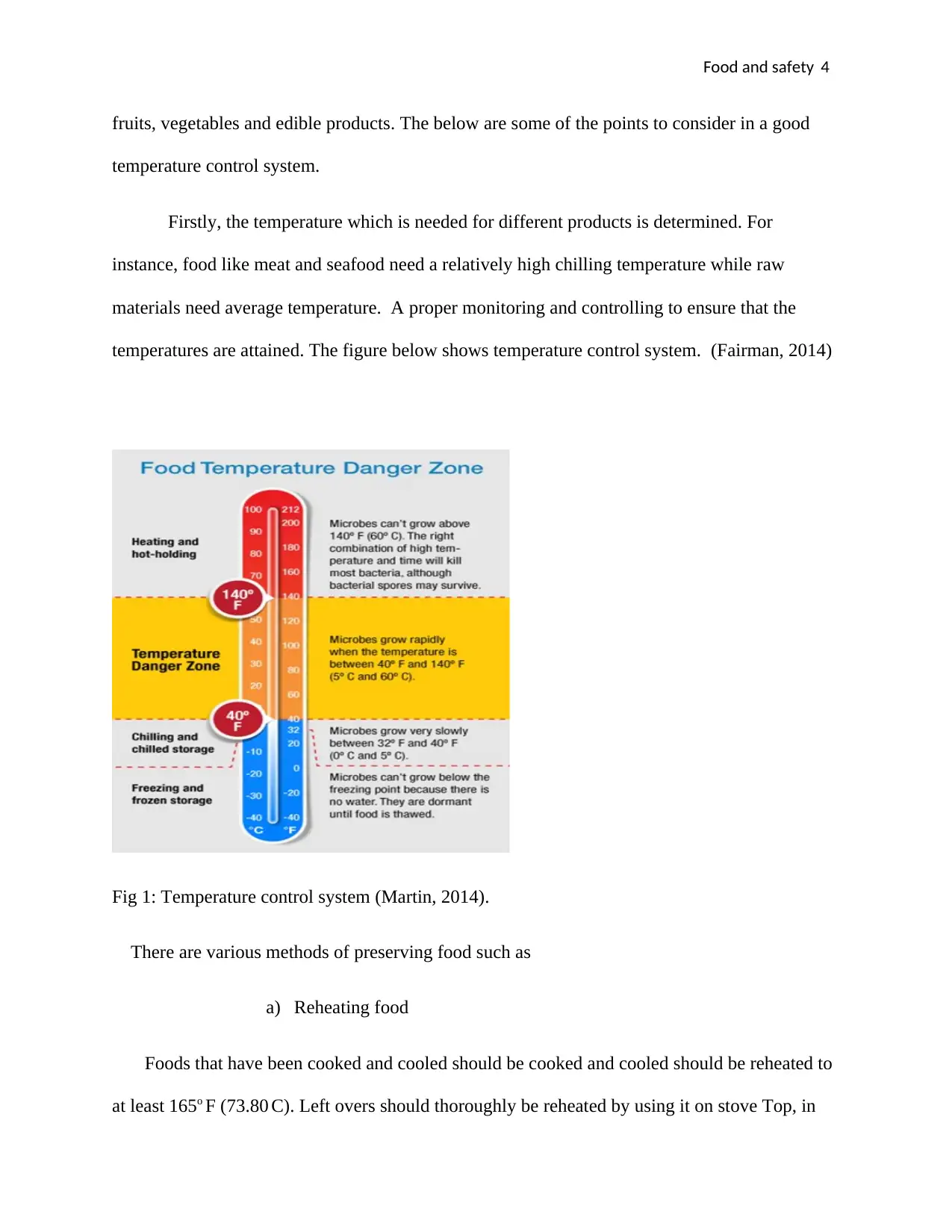
Food and safety 4
fruits, vegetables and edible products. The below are some of the points to consider in a good
temperature control system.
Firstly, the temperature which is needed for different products is determined. For
instance, food like meat and seafood need a relatively high chilling temperature while raw
materials need average temperature. A proper monitoring and controlling to ensure that the
temperatures are attained. The figure below shows temperature control system. (Fairman, 2014)
Fig 1: Temperature control system (Martin, 2014).
There are various methods of preserving food such as
a) Reheating food
Foods that have been cooked and cooled should be cooked and cooled should be reheated to
at least 165o F (73.80 C). Left overs should thoroughly be reheated by using it on stove Top, in
fruits, vegetables and edible products. The below are some of the points to consider in a good
temperature control system.
Firstly, the temperature which is needed for different products is determined. For
instance, food like meat and seafood need a relatively high chilling temperature while raw
materials need average temperature. A proper monitoring and controlling to ensure that the
temperatures are attained. The figure below shows temperature control system. (Fairman, 2014)
Fig 1: Temperature control system (Martin, 2014).
There are various methods of preserving food such as
a) Reheating food
Foods that have been cooked and cooled should be cooked and cooled should be reheated to
at least 165o F (73.80 C). Left overs should thoroughly be reheated by using it on stove Top, in
Paraphrase This Document
Need a fresh take? Get an instant paraphrase of this document with our AI Paraphraser
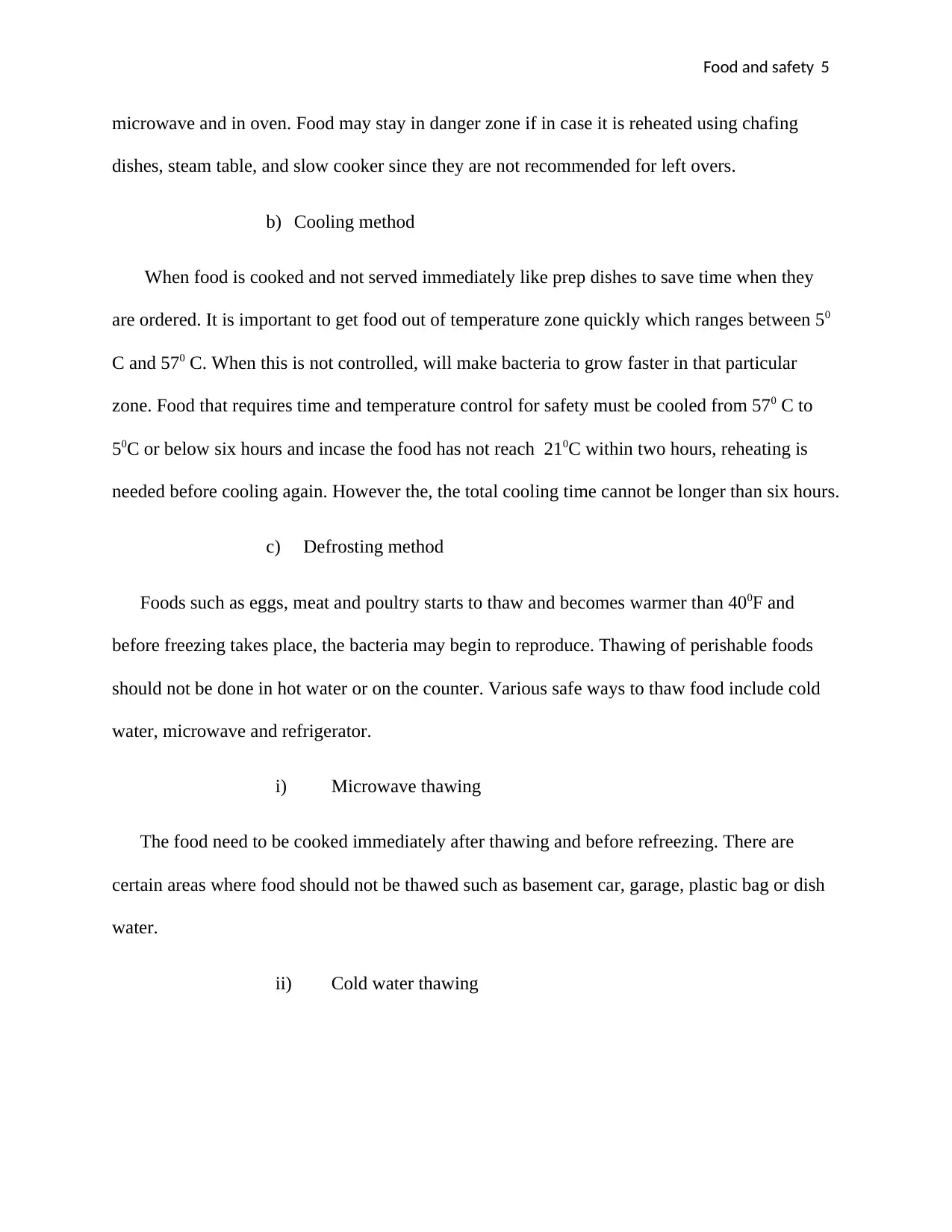
Food and safety 5
microwave and in oven. Food may stay in danger zone if in case it is reheated using chafing
dishes, steam table, and slow cooker since they are not recommended for left overs.
b) Cooling method
When food is cooked and not served immediately like prep dishes to save time when they
are ordered. It is important to get food out of temperature zone quickly which ranges between 50
C and 570 C. When this is not controlled, will make bacteria to grow faster in that particular
zone. Food that requires time and temperature control for safety must be cooled from 570 C to
50C or below six hours and incase the food has not reach 210C within two hours, reheating is
needed before cooling again. However the, the total cooling time cannot be longer than six hours.
c) Defrosting method
Foods such as eggs, meat and poultry starts to thaw and becomes warmer than 400F and
before freezing takes place, the bacteria may begin to reproduce. Thawing of perishable foods
should not be done in hot water or on the counter. Various safe ways to thaw food include cold
water, microwave and refrigerator.
i) Microwave thawing
The food need to be cooked immediately after thawing and before refreezing. There are
certain areas where food should not be thawed such as basement car, garage, plastic bag or dish
water.
ii) Cold water thawing
microwave and in oven. Food may stay in danger zone if in case it is reheated using chafing
dishes, steam table, and slow cooker since they are not recommended for left overs.
b) Cooling method
When food is cooked and not served immediately like prep dishes to save time when they
are ordered. It is important to get food out of temperature zone quickly which ranges between 50
C and 570 C. When this is not controlled, will make bacteria to grow faster in that particular
zone. Food that requires time and temperature control for safety must be cooled from 570 C to
50C or below six hours and incase the food has not reach 210C within two hours, reheating is
needed before cooling again. However the, the total cooling time cannot be longer than six hours.
c) Defrosting method
Foods such as eggs, meat and poultry starts to thaw and becomes warmer than 400F and
before freezing takes place, the bacteria may begin to reproduce. Thawing of perishable foods
should not be done in hot water or on the counter. Various safe ways to thaw food include cold
water, microwave and refrigerator.
i) Microwave thawing
The food need to be cooked immediately after thawing and before refreezing. There are
certain areas where food should not be thawed such as basement car, garage, plastic bag or dish
water.
ii) Cold water thawing
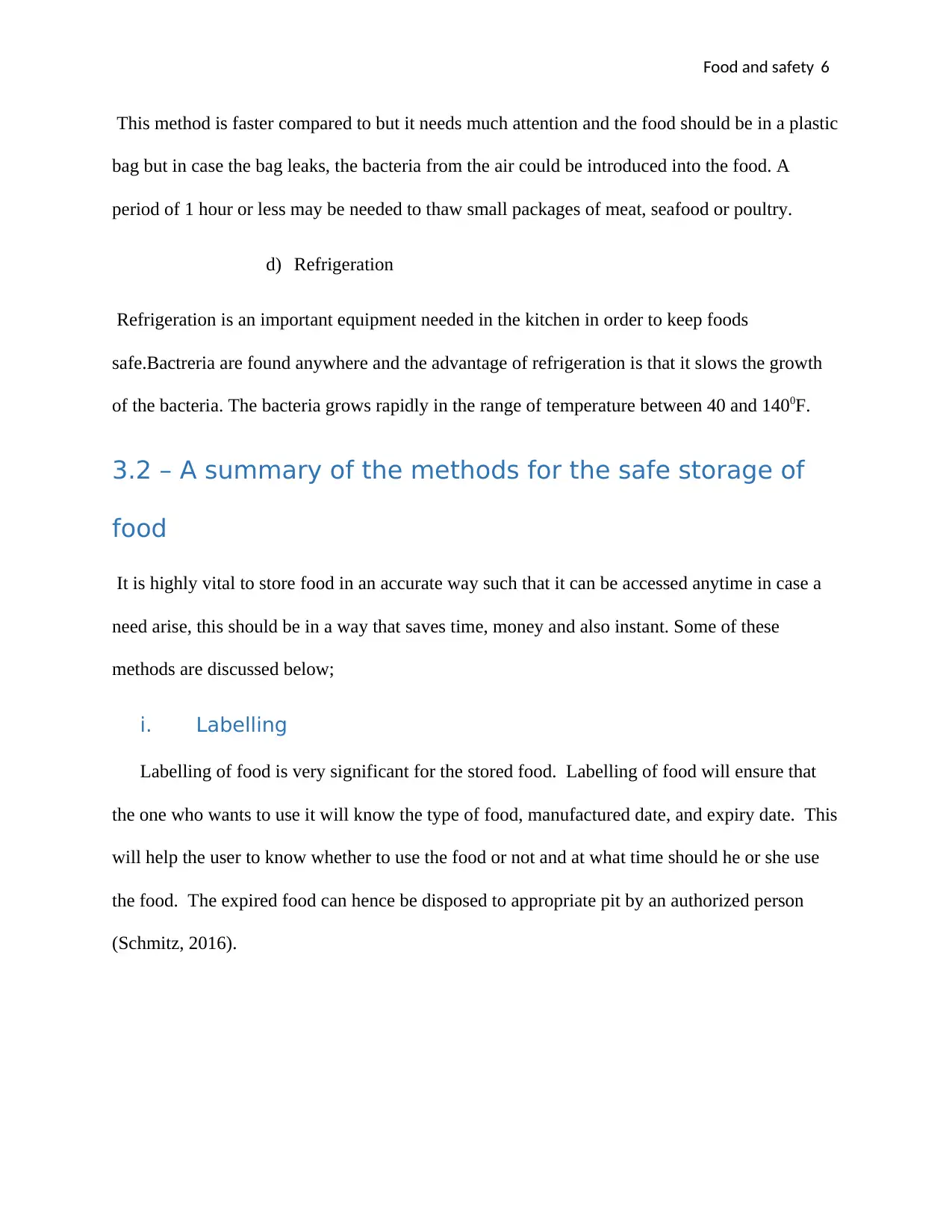
Food and safety 6
This method is faster compared to but it needs much attention and the food should be in a plastic
bag but in case the bag leaks, the bacteria from the air could be introduced into the food. A
period of 1 hour or less may be needed to thaw small packages of meat, seafood or poultry.
d) Refrigeration
Refrigeration is an important equipment needed in the kitchen in order to keep foods
safe.Bactreria are found anywhere and the advantage of refrigeration is that it slows the growth
of the bacteria. The bacteria grows rapidly in the range of temperature between 40 and 1400F.
3.2 – A summary of the methods for the safe storage of
food
It is highly vital to store food in an accurate way such that it can be accessed anytime in case a
need arise, this should be in a way that saves time, money and also instant. Some of these
methods are discussed below;
i. Labelling
Labelling of food is very significant for the stored food. Labelling of food will ensure that
the one who wants to use it will know the type of food, manufactured date, and expiry date. This
will help the user to know whether to use the food or not and at what time should he or she use
the food. The expired food can hence be disposed to appropriate pit by an authorized person
(Schmitz, 2016).
This method is faster compared to but it needs much attention and the food should be in a plastic
bag but in case the bag leaks, the bacteria from the air could be introduced into the food. A
period of 1 hour or less may be needed to thaw small packages of meat, seafood or poultry.
d) Refrigeration
Refrigeration is an important equipment needed in the kitchen in order to keep foods
safe.Bactreria are found anywhere and the advantage of refrigeration is that it slows the growth
of the bacteria. The bacteria grows rapidly in the range of temperature between 40 and 1400F.
3.2 – A summary of the methods for the safe storage of
food
It is highly vital to store food in an accurate way such that it can be accessed anytime in case a
need arise, this should be in a way that saves time, money and also instant. Some of these
methods are discussed below;
i. Labelling
Labelling of food is very significant for the stored food. Labelling of food will ensure that
the one who wants to use it will know the type of food, manufactured date, and expiry date. This
will help the user to know whether to use the food or not and at what time should he or she use
the food. The expired food can hence be disposed to appropriate pit by an authorized person
(Schmitz, 2016).
⊘ This is a preview!⊘
Do you want full access?
Subscribe today to unlock all pages.

Trusted by 1+ million students worldwide
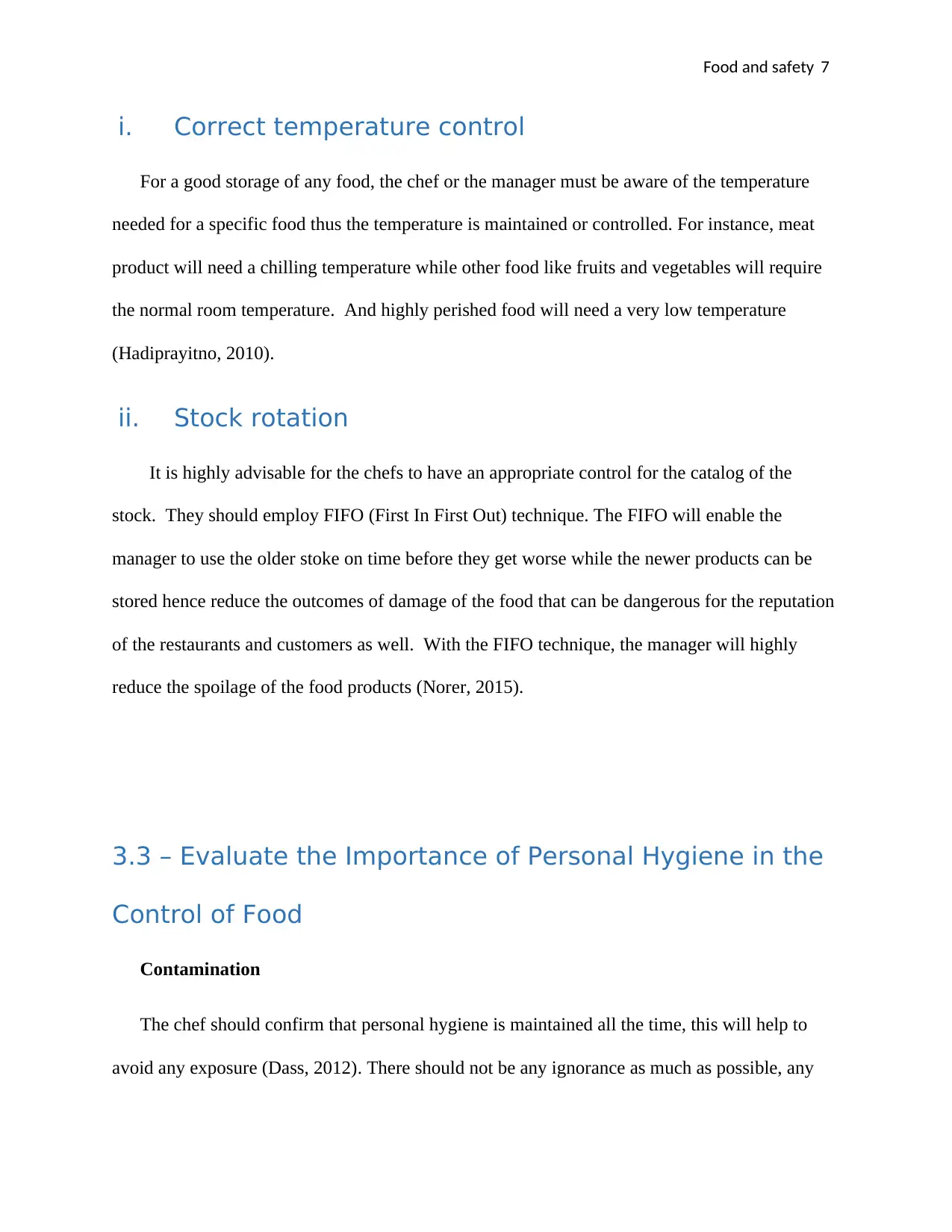
Food and safety 7
i. Correct temperature control
For a good storage of any food, the chef or the manager must be aware of the temperature
needed for a specific food thus the temperature is maintained or controlled. For instance, meat
product will need a chilling temperature while other food like fruits and vegetables will require
the normal room temperature. And highly perished food will need a very low temperature
(Hadiprayitno, 2010).
ii. Stock rotation
It is highly advisable for the chefs to have an appropriate control for the catalog of the
stock. They should employ FIFO (First In First Out) technique. The FIFO will enable the
manager to use the older stoke on time before they get worse while the newer products can be
stored hence reduce the outcomes of damage of the food that can be dangerous for the reputation
of the restaurants and customers as well. With the FIFO technique, the manager will highly
reduce the spoilage of the food products (Norer, 2015).
3.3 – Evaluate the Importance of Personal Hygiene in the
Control of Food
Contamination
The chef should confirm that personal hygiene is maintained all the time, this will help to
avoid any exposure (Dass, 2012). There should not be any ignorance as much as possible, any
i. Correct temperature control
For a good storage of any food, the chef or the manager must be aware of the temperature
needed for a specific food thus the temperature is maintained or controlled. For instance, meat
product will need a chilling temperature while other food like fruits and vegetables will require
the normal room temperature. And highly perished food will need a very low temperature
(Hadiprayitno, 2010).
ii. Stock rotation
It is highly advisable for the chefs to have an appropriate control for the catalog of the
stock. They should employ FIFO (First In First Out) technique. The FIFO will enable the
manager to use the older stoke on time before they get worse while the newer products can be
stored hence reduce the outcomes of damage of the food that can be dangerous for the reputation
of the restaurants and customers as well. With the FIFO technique, the manager will highly
reduce the spoilage of the food products (Norer, 2015).
3.3 – Evaluate the Importance of Personal Hygiene in the
Control of Food
Contamination
The chef should confirm that personal hygiene is maintained all the time, this will help to
avoid any exposure (Dass, 2012). There should not be any ignorance as much as possible, any
Paraphrase This Document
Need a fresh take? Get an instant paraphrase of this document with our AI Paraphraser
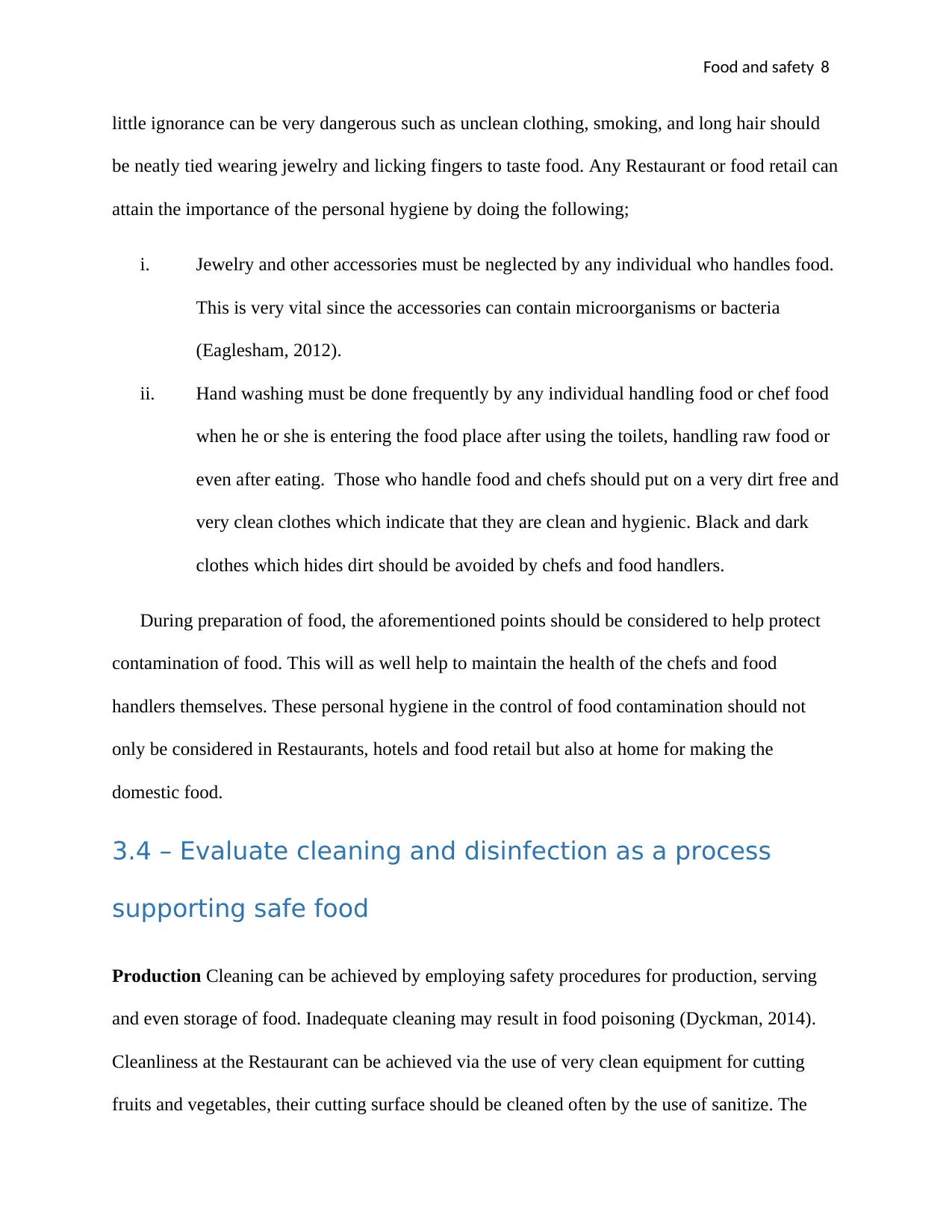
Food and safety 8
little ignorance can be very dangerous such as unclean clothing, smoking, and long hair should
be neatly tied wearing jewelry and licking fingers to taste food. Any Restaurant or food retail can
attain the importance of the personal hygiene by doing the following;
i. Jewelry and other accessories must be neglected by any individual who handles food.
This is very vital since the accessories can contain microorganisms or bacteria
(Eaglesham, 2012).
ii. Hand washing must be done frequently by any individual handling food or chef food
when he or she is entering the food place after using the toilets, handling raw food or
even after eating. Those who handle food and chefs should put on a very dirt free and
very clean clothes which indicate that they are clean and hygienic. Black and dark
clothes which hides dirt should be avoided by chefs and food handlers.
During preparation of food, the aforementioned points should be considered to help protect
contamination of food. This will as well help to maintain the health of the chefs and food
handlers themselves. These personal hygiene in the control of food contamination should not
only be considered in Restaurants, hotels and food retail but also at home for making the
domestic food.
3.4 – Evaluate cleaning and disinfection as a process
supporting safe food
Production Cleaning can be achieved by employing safety procedures for production, serving
and even storage of food. Inadequate cleaning may result in food poisoning (Dyckman, 2014).
Cleanliness at the Restaurant can be achieved via the use of very clean equipment for cutting
fruits and vegetables, their cutting surface should be cleaned often by the use of sanitize. The
little ignorance can be very dangerous such as unclean clothing, smoking, and long hair should
be neatly tied wearing jewelry and licking fingers to taste food. Any Restaurant or food retail can
attain the importance of the personal hygiene by doing the following;
i. Jewelry and other accessories must be neglected by any individual who handles food.
This is very vital since the accessories can contain microorganisms or bacteria
(Eaglesham, 2012).
ii. Hand washing must be done frequently by any individual handling food or chef food
when he or she is entering the food place after using the toilets, handling raw food or
even after eating. Those who handle food and chefs should put on a very dirt free and
very clean clothes which indicate that they are clean and hygienic. Black and dark
clothes which hides dirt should be avoided by chefs and food handlers.
During preparation of food, the aforementioned points should be considered to help protect
contamination of food. This will as well help to maintain the health of the chefs and food
handlers themselves. These personal hygiene in the control of food contamination should not
only be considered in Restaurants, hotels and food retail but also at home for making the
domestic food.
3.4 – Evaluate cleaning and disinfection as a process
supporting safe food
Production Cleaning can be achieved by employing safety procedures for production, serving
and even storage of food. Inadequate cleaning may result in food poisoning (Dyckman, 2014).
Cleanliness at the Restaurant can be achieved via the use of very clean equipment for cutting
fruits and vegetables, their cutting surface should be cleaned often by the use of sanitize. The
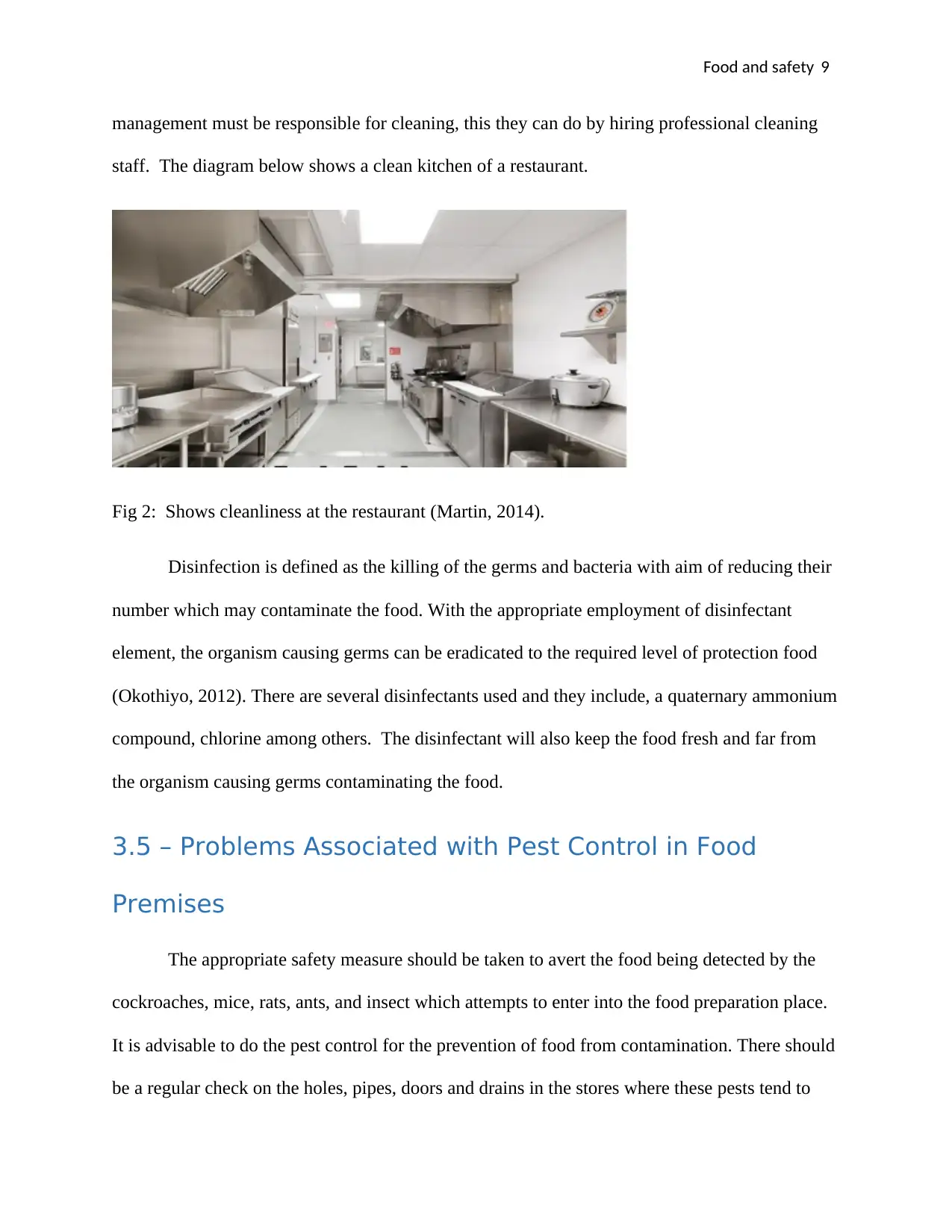
Food and safety 9
management must be responsible for cleaning, this they can do by hiring professional cleaning
staff. The diagram below shows a clean kitchen of a restaurant.
Fig 2: Shows cleanliness at the restaurant (Martin, 2014).
Disinfection is defined as the killing of the germs and bacteria with aim of reducing their
number which may contaminate the food. With the appropriate employment of disinfectant
element, the organism causing germs can be eradicated to the required level of protection food
(Okothiyo, 2012). There are several disinfectants used and they include, a quaternary ammonium
compound, chlorine among others. The disinfectant will also keep the food fresh and far from
the organism causing germs contaminating the food.
3.5 – Problems Associated with Pest Control in Food
Premises
The appropriate safety measure should be taken to avert the food being detected by the
cockroaches, mice, rats, ants, and insect which attempts to enter into the food preparation place.
It is advisable to do the pest control for the prevention of food from contamination. There should
be a regular check on the holes, pipes, doors and drains in the stores where these pests tend to
management must be responsible for cleaning, this they can do by hiring professional cleaning
staff. The diagram below shows a clean kitchen of a restaurant.
Fig 2: Shows cleanliness at the restaurant (Martin, 2014).
Disinfection is defined as the killing of the germs and bacteria with aim of reducing their
number which may contaminate the food. With the appropriate employment of disinfectant
element, the organism causing germs can be eradicated to the required level of protection food
(Okothiyo, 2012). There are several disinfectants used and they include, a quaternary ammonium
compound, chlorine among others. The disinfectant will also keep the food fresh and far from
the organism causing germs contaminating the food.
3.5 – Problems Associated with Pest Control in Food
Premises
The appropriate safety measure should be taken to avert the food being detected by the
cockroaches, mice, rats, ants, and insect which attempts to enter into the food preparation place.
It is advisable to do the pest control for the prevention of food from contamination. There should
be a regular check on the holes, pipes, doors and drains in the stores where these pests tend to
⊘ This is a preview!⊘
Do you want full access?
Subscribe today to unlock all pages.

Trusted by 1+ million students worldwide
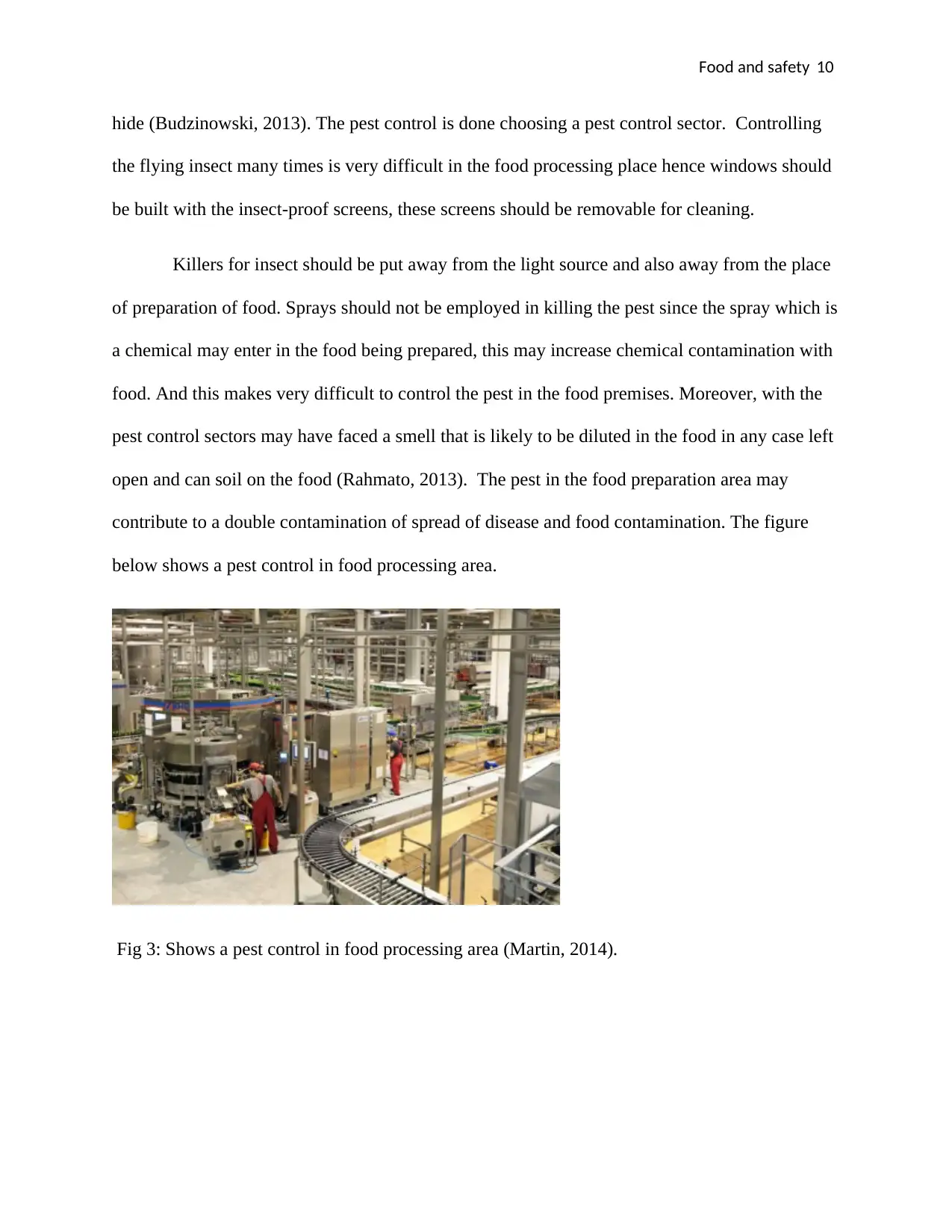
Food and safety 10
hide (Budzinowski, 2013). The pest control is done choosing a pest control sector. Controlling
the flying insect many times is very difficult in the food processing place hence windows should
be built with the insect-proof screens, these screens should be removable for cleaning.
Killers for insect should be put away from the light source and also away from the place
of preparation of food. Sprays should not be employed in killing the pest since the spray which is
a chemical may enter in the food being prepared, this may increase chemical contamination with
food. And this makes very difficult to control the pest in the food premises. Moreover, with the
pest control sectors may have faced a smell that is likely to be diluted in the food in any case left
open and can soil on the food (Rahmato, 2013). The pest in the food preparation area may
contribute to a double contamination of spread of disease and food contamination. The figure
below shows a pest control in food processing area.
Fig 3: Shows a pest control in food processing area (Martin, 2014).
hide (Budzinowski, 2013). The pest control is done choosing a pest control sector. Controlling
the flying insect many times is very difficult in the food processing place hence windows should
be built with the insect-proof screens, these screens should be removable for cleaning.
Killers for insect should be put away from the light source and also away from the place
of preparation of food. Sprays should not be employed in killing the pest since the spray which is
a chemical may enter in the food being prepared, this may increase chemical contamination with
food. And this makes very difficult to control the pest in the food premises. Moreover, with the
pest control sectors may have faced a smell that is likely to be diluted in the food in any case left
open and can soil on the food (Rahmato, 2013). The pest in the food preparation area may
contribute to a double contamination of spread of disease and food contamination. The figure
below shows a pest control in food processing area.
Fig 3: Shows a pest control in food processing area (Martin, 2014).
Paraphrase This Document
Need a fresh take? Get an instant paraphrase of this document with our AI Paraphraser
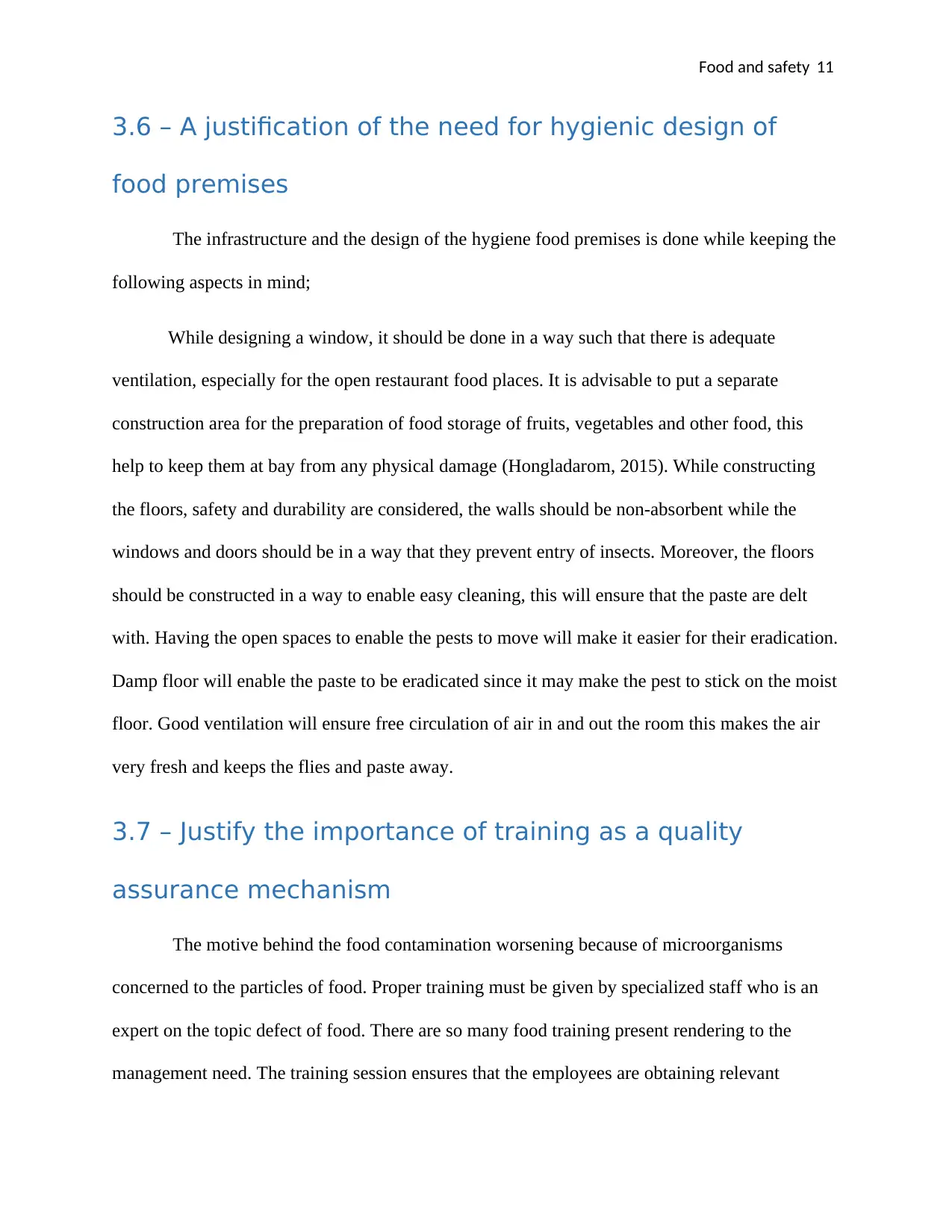
Food and safety 11
3.6 – A justification of the need for hygienic design of
food premises
The infrastructure and the design of the hygiene food premises is done while keeping the
following aspects in mind;
While designing a window, it should be done in a way such that there is adequate
ventilation, especially for the open restaurant food places. It is advisable to put a separate
construction area for the preparation of food storage of fruits, vegetables and other food, this
help to keep them at bay from any physical damage (Hongladarom, 2015). While constructing
the floors, safety and durability are considered, the walls should be non-absorbent while the
windows and doors should be in a way that they prevent entry of insects. Moreover, the floors
should be constructed in a way to enable easy cleaning, this will ensure that the paste are delt
with. Having the open spaces to enable the pests to move will make it easier for their eradication.
Damp floor will enable the paste to be eradicated since it may make the pest to stick on the moist
floor. Good ventilation will ensure free circulation of air in and out the room this makes the air
very fresh and keeps the flies and paste away.
3.7 – Justify the importance of training as a quality
assurance mechanism
The motive behind the food contamination worsening because of microorganisms
concerned to the particles of food. Proper training must be given by specialized staff who is an
expert on the topic defect of food. There are so many food training present rendering to the
management need. The training session ensures that the employees are obtaining relevant
3.6 – A justification of the need for hygienic design of
food premises
The infrastructure and the design of the hygiene food premises is done while keeping the
following aspects in mind;
While designing a window, it should be done in a way such that there is adequate
ventilation, especially for the open restaurant food places. It is advisable to put a separate
construction area for the preparation of food storage of fruits, vegetables and other food, this
help to keep them at bay from any physical damage (Hongladarom, 2015). While constructing
the floors, safety and durability are considered, the walls should be non-absorbent while the
windows and doors should be in a way that they prevent entry of insects. Moreover, the floors
should be constructed in a way to enable easy cleaning, this will ensure that the paste are delt
with. Having the open spaces to enable the pests to move will make it easier for their eradication.
Damp floor will enable the paste to be eradicated since it may make the pest to stick on the moist
floor. Good ventilation will ensure free circulation of air in and out the room this makes the air
very fresh and keeps the flies and paste away.
3.7 – Justify the importance of training as a quality
assurance mechanism
The motive behind the food contamination worsening because of microorganisms
concerned to the particles of food. Proper training must be given by specialized staff who is an
expert on the topic defect of food. There are so many food training present rendering to the
management need. The training session ensures that the employees are obtaining relevant
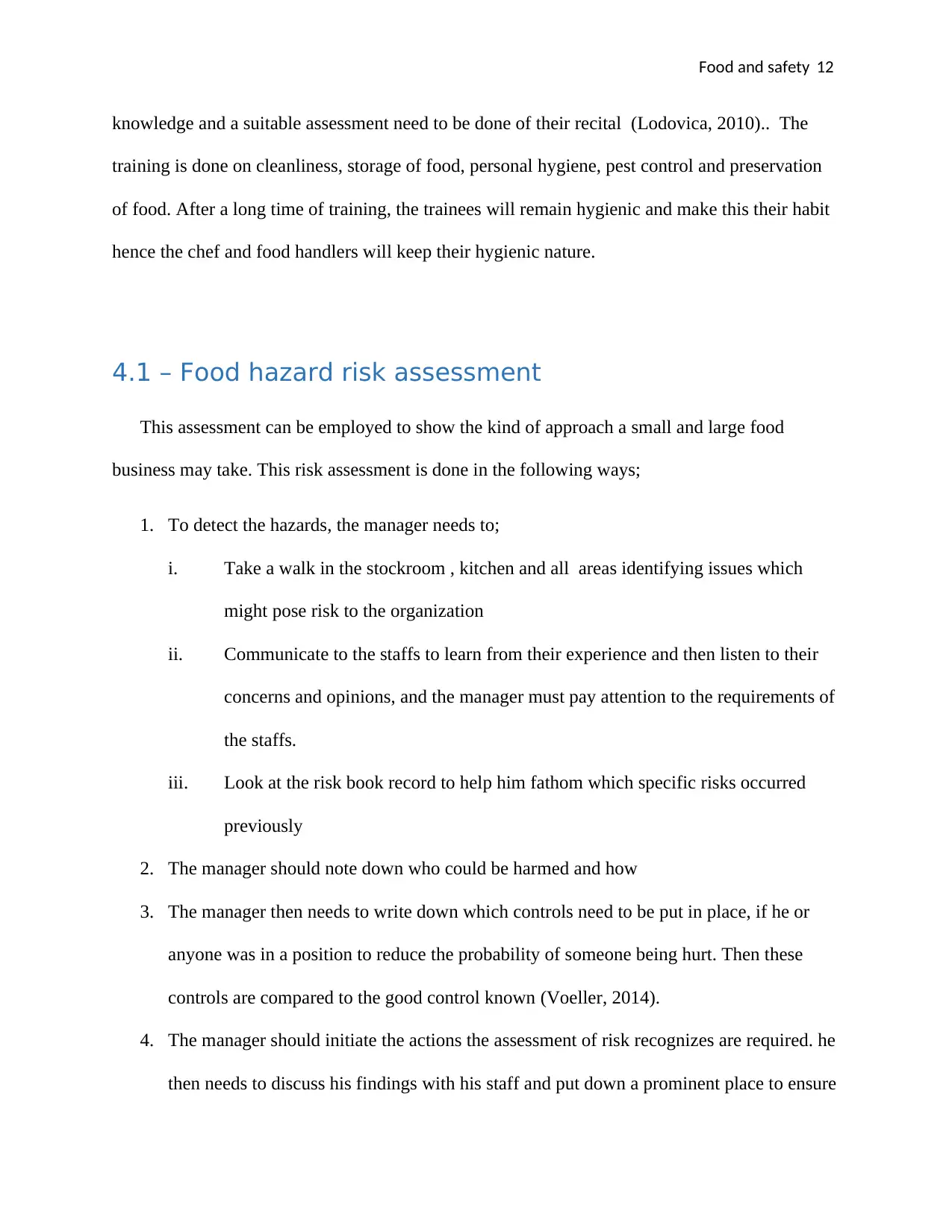
Food and safety 12
knowledge and a suitable assessment need to be done of their recital (Lodovica, 2010).. The
training is done on cleanliness, storage of food, personal hygiene, pest control and preservation
of food. After a long time of training, the trainees will remain hygienic and make this their habit
hence the chef and food handlers will keep their hygienic nature.
4.1 – Food hazard risk assessment
This assessment can be employed to show the kind of approach a small and large food
business may take. This risk assessment is done in the following ways;
1. To detect the hazards, the manager needs to;
i. Take a walk in the stockroom , kitchen and all areas identifying issues which
might pose risk to the organization
ii. Communicate to the staffs to learn from their experience and then listen to their
concerns and opinions, and the manager must pay attention to the requirements of
the staffs.
iii. Look at the risk book record to help him fathom which specific risks occurred
previously
2. The manager should note down who could be harmed and how
3. The manager then needs to write down which controls need to be put in place, if he or
anyone was in a position to reduce the probability of someone being hurt. Then these
controls are compared to the good control known (Voeller, 2014).
4. The manager should initiate the actions the assessment of risk recognizes are required. he
then needs to discuss his findings with his staff and put down a prominent place to ensure
knowledge and a suitable assessment need to be done of their recital (Lodovica, 2010).. The
training is done on cleanliness, storage of food, personal hygiene, pest control and preservation
of food. After a long time of training, the trainees will remain hygienic and make this their habit
hence the chef and food handlers will keep their hygienic nature.
4.1 – Food hazard risk assessment
This assessment can be employed to show the kind of approach a small and large food
business may take. This risk assessment is done in the following ways;
1. To detect the hazards, the manager needs to;
i. Take a walk in the stockroom , kitchen and all areas identifying issues which
might pose risk to the organization
ii. Communicate to the staffs to learn from their experience and then listen to their
concerns and opinions, and the manager must pay attention to the requirements of
the staffs.
iii. Look at the risk book record to help him fathom which specific risks occurred
previously
2. The manager should note down who could be harmed and how
3. The manager then needs to write down which controls need to be put in place, if he or
anyone was in a position to reduce the probability of someone being hurt. Then these
controls are compared to the good control known (Voeller, 2014).
4. The manager should initiate the actions the assessment of risk recognizes are required. he
then needs to discuss his findings with his staff and put down a prominent place to ensure
⊘ This is a preview!⊘
Do you want full access?
Subscribe today to unlock all pages.

Trusted by 1+ million students worldwide
1 out of 19
Related Documents
Your All-in-One AI-Powered Toolkit for Academic Success.
+13062052269
info@desklib.com
Available 24*7 on WhatsApp / Email
![[object Object]](/_next/static/media/star-bottom.7253800d.svg)
Unlock your academic potential
Copyright © 2020–2025 A2Z Services. All Rights Reserved. Developed and managed by ZUCOL.




